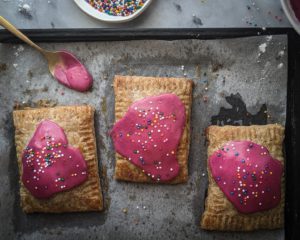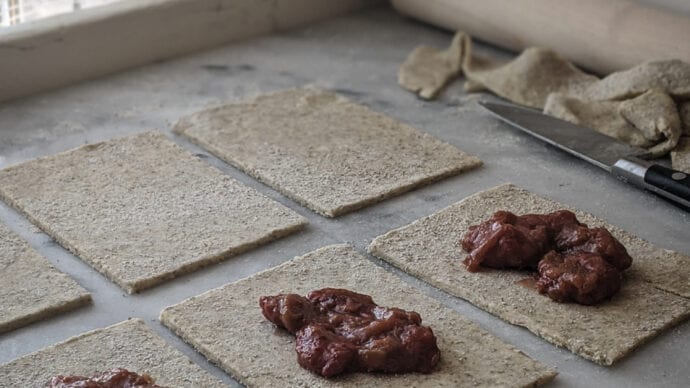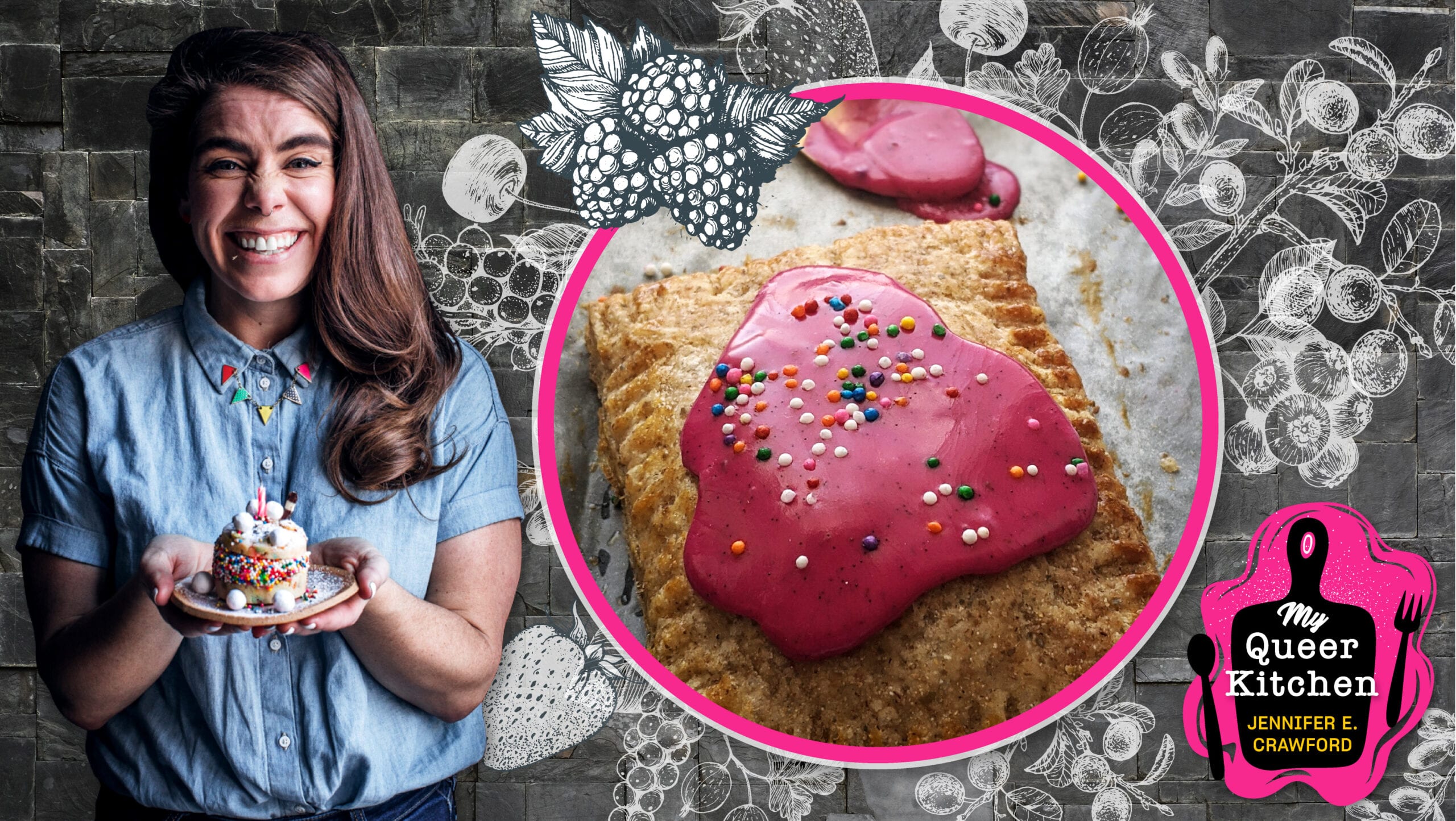This story is part of My Queer Kitchen with Jennifer E. Crawford: Pandemic Edition, a cooking series promoting community, ingenuity and delectability during the time of COVID-19.
“James Beard was…gay?” Hot tears of joy and confusion and relief stung the backs of my eyes. How had this detail been so aggressively absent from everything else I’d read about him, the man for whom America’s most prestigious culinary awards are named? Two years ago, I tore through Jon Shadel’s article on Beard, my heart pounding with recognition. It felt like my brain and heart had just over-proofed their limits.
Of course James Beard was gay: His effervescent and unadulterated love of pleasure for pleasure’s sake; the joyful revelry of his culinary largess, such a bold departure from the food world at the time and the exact thing that made him so remarkable. How had his sexuality been rendered so unimportant as to be scarcely mentioned, even in posthumous memoirs? I am always hungry for queer culinary icons, community mentors, mentees. Especially now, especially during my queer culinary quarantine.
“I’m here, I’m queer, my steaks are perfectly seared!”
I’m queer, and I’m gender creative. I won MasterChef Canada last year. Articles about me tend to have a lengthy explanation in the first paragraph about they/them pronouns. I’m what some might call straight-passing. Unless I come out to straight folks, I’m read as a straight cis woman, none of which feels right or good. I’m less like Shrek the onion and more like an opaque Victorian jelly mold—nostalgically campy, phallic, confusing (is this… edible?), the milk wiggle obscuring fruitiness within. Not for everybody. Queers, however, usually see me immediately. Straight people see a Jennifer with a ponytail who is creative. I guess they’re not entirely wrong. But I don’t want to go the way of James Beard, experiencing casual erasure or compartmentalizing the things that make me great at what I do. I’m here, I’m queer, my steaks are perfectly seared!
Is queer food a real thing? Is it something we can define? Is this really what we need to talk about, during a pandemic of all things? I can’t stop thinking about it though, and the inventive pantry cooking of this quarantine has the idea rising in importance like everyone’s beautiful sourdoughs. If I try and deflate it, it rises with more urgency. My own gender and sexuality are always getting away from me, like cold butter sliding across a hot pan. Just when I think it’s somewhere, it melts away. Maybe the fact that I’m just generally flaming has its own infinite Maillard reaction on my heart’s desires. Maybe queer food is no more fixed than my orientations. Maybe that’s why it feels so urgent to talk about, especially now.
Not that everyone wants to talk about queer food, or even being a queer chef. In his own award-winning article on James Beard, John Birdsall discusses the challenges he faced while trying to write an article about queerness and food: The immediate, prickly-pear resistance many chefs have toward using any sort of qualifier; how terms like “queer chef” or “gay chef” can curdle the stomach when straight cis male chefs are simply referred to as “Chef.” But still, the question keeps rising in my heart. Queer food surely must be more than the explosion of rainbow-hued cakes and pastries during Pride, or straight chefs declaring “love is love,” right? If other (queer) chefs don’t want to talk about this then, for the love of Dorothy, why talk about it during a pandemic?
The kitchens are all closed right now, and any of the cheffing events I was supposed to do are cancelled. It seems like an apt time to discuss queer food and queer kitchens, yes? We finally have time! I’ve worked in a few kitchens this past year, in different provinces, for different lengths of time. I’ve heard staff in all of them—yes, even in some of Canada’s most beloved kitchens where they should “know better”—openly mock the #MeToo movement, or compare a gruelling Friday night service to sexual assault. I was often the only non-cis male in the kitchen, and it often felt like taking a word-bullet to the guts. Sometimes I would speak up in protest—other times I was outside my body before I knew it, fighting hot frustration tears and dissociating just enough to survive the service. One time, I remember my heart pounding so loud in my ears that I couldn’t hear our sous calling out the orders.
What I remember the most? The crushing silence of the male cooks. Their sudden, intense interest in their hand calluses. Their quiet shaming of me for saying something by simply…doing nothing at all. What a disappointment. Their macho bravado was matched only by their cowardice. One time, after a particularly bad incident, one of them wordlessly offered me a loaf of leftover bread at the end of service, an apologetic little communion. I ate it and cried the whole way home.
Those felt like straight patriarchal kitchens. It was not a place where I felt comfortable coming out as queer, where men clearly couldn’t care less about my gender or pronouns, where I wasn’t welcome. Heading off the “nOt aLl KiTcHeNs” comments: Yes, you’re right, not all kitchens, thankfully. I’ve had the delight of cooking in some of those, too. But there are an awful lot of those straight patriarchal kitchens, and that’s not good. The industry has just been eviscerated by this pandemic; may it be resurrected with the most vulnerable put front and centre. These are perfect times to be discussing such things. Everything has fallen apart. Can’t we do better, as it’s cobbled back together? What do we keep? What can get 86ed already?
I promised to talk about queer food, didn’t I? We’re getting there. Is queer food just frivolous right now? It feels urgent to me because times of strife have historically been used to limit certain social freedoms as though they are secondary distractions to the primary purpose, the greater good, the status quo, the economy. But that primary purpose—the status quo, the economy—wasn’t a great good for most of us. The pandemic has seen freedoms trampled already. Arizona has quietly passed a transphobic bill preventing trans female youth from playing school sports. Idaho passed the same, and on top of that passed a bill preventing trans people from obtaining a new birth certificate with their correct name and gender (announced on Trans Day of Visibility no less). And yeesh: Texas and Ohio have already limited almost all abortions. Who knows what other freedoms will be trampled by the time this is published. It’s happening at an exponential rate.
So then, is talking queer food in a quarantine a frivolous consideration? Frivolous to whom?
“To me, queer food is not frivolous. It has never been frivolous. It is survival. Also, it is delicious.”
Might it be important to the queers who are isolated from their communities, in search of a tangible connection through this hellscape? To those who would like a new birth certificate but can’t obtain one but, dammit, still have to cook dinner? To those housed in homophobic and transphobic living situations, trying to find even some small comforts in their limited pantry? To those queers trying to stay sober as their Instagram stories are rife with people taking shots all day long? To those queers whose main mode of coping with trauma is expression and healing through food?
To me, queer food is not frivolous. It has never been frivolous. It is survival. Also, it is delicious.
I have lots of questions about queer food, queer chefs and everything to do with culinary queerness during this quarantine and beyond. When you have long been told that your sexuality, gender and relationship configurations are simply impossible, even illegal and subject to violence, and yet there you are, joyfully living them—how can this not come to bear on how you approach food? Seemingly impossible combinations and techniques don’t scare me. That’s my hecking wheelhouse, sexuality or food or otherwise. I don’t think this is exclusive to queerness, but I sure do think it emboldens us to be inventive in the pantry during these scary times. Queers have always known how to make something fabulous out of nothing—community even in disparate suffering, love and connection and compassion out of fear. And is that not what pantry cooking is all about?
My culinary sensibilities and my queerness aren’t separate—not anytime, and not during this pandemic. Nor are those things separate from my sobriety, my Jew-ish-ness, my working-class Nova Scotian heart. We’re made of multiplicities and not designed to be partitioned out. Other folks cannot make substitutions or omissions to make us more fitting to their palate and preferences. I’m not a pile of ingredients ready to be made into something: I’m the fully baked fruitcake. Remove any one ingredient, and it’s simply a recipe gone wrong. I’m a cream puff, a big plate of meat and potatoes, a granola snack and always, forever, fruity. I’m so excited and honoured to explore these questions and delicious queernesses with you in the weeks to come.
In the meantime, I’ve been craving the comforts of nostalgia, carbs and creation. With what was on hand in my queer kitchen, I’ve created a poptart recipe I’m excited to share with you. I made substitutions and freestyled as needed to get here, and I encourage you to do the same. Maybe they’re queer: At the very least, I can guarantee these tarts are fruity.

Strawberry rhubarb rye poptarts with beet & vanilla bean icing
Makes 6 pastries
Dough
½ cup butter, put in freezer for an hour
1 cup all-purpose flour
½ cup rye flour (if you don’t have rye, don’t worry—just use more all-purpose instead)
2 tbsp sugar
2 tsp kosher salt
½ cup ice water
2 egg yolks
Filling
12 tbsp strawberry rhubarb jam (or any leftover jam from the fridge)
Icing
1 cup icing sugar
1 vanilla bean or ¼ tsp vanilla extract
2 tbsp beet juice + 1 tsp (or water and food colouring)
Sprinkles!
Method
- Preheat oven to 400F.
- Grate the cold butter onto a plate. In a large bowl, combine the flours, sugar and salt. Whisk so they’re evenly distributed.
- Transfer the grated butter into the flour mixture, tossing to coat. You’ll want to work quickly—keeping the butter cold throughout this process is what ensures a nice flaky pastry.
- Add ½ cup ice cold water, and stir with a spoon to combine. Once combined, knead in the bowl until it becomes a nice dough but there are still visible butter chunks. Shape into two rectangles. Wrap in plastic wrap, and let rest in the fridge for one hour.
- While the dough chills, you chill <3
- Separate two eggs, whisking yolks together in a bowl.
- Retrieve the two dough rectangles from the fridge. At this point you will want to work quickly to help prevent the butter in the pastry from melting. Roll each section out into equal size rectangles until the dough is around a ¼ inch thick. Trim with a paring knife to square up edges.

- Cut each side into six equal rectangles (that’s 12, total). I always use a ruler for this part, but maybe you’re better at eyeballing than me!
- On each of the six rectangles, spoon 2 tbsp of your filling. Using the whisked egg yolks, brush all around the filling. (This is to seal the pastry and prevent the filling from leaking.) Lay a pastry rectangle over top of each. One at a time, seal the edges with a fork. I do the narrow sides first, then the longer sides.
- Brush edges of pastry with remaining egg yolk. Return to fridge for roughly 30 minutes to give the butter a chance to get cool again before baking.
- On a parchment-lined baking sheet (no parchment? Try greasing the baking sheet; it should work), bake the pastries for around 20 minutes in the preheated oven until the edges are browned and the tops lightly toasted.
- While they are baking, prepare the icing: In a bowl, put 1 cup of icing sugar (and seeds of 1 vanilla bean, if using). Add 2 tbsp of beet juice (or water and colouring, if that’s what you’ve got), stirring very slowly until it comes together. Add the vanilla extract at this time, if using. Add juice a drop at a time, until it is a spoonable but very thick consistency.
- Remove pastries from oven and let cool until they’re as cool as you are, a.k.a. very cool. Then, spoon 1 tbsp icing over top of each. Toss a generous dusting of sprinkles over the icing before it becomes set.
- You did it! Reflect on how totally great and powerful it is that you just learned how to make something so pretty, delicious and nourishing out of a bunch of ingredients you had around anyways. I’m proud of you!


 Why you can trust Xtra
Why you can trust Xtra


